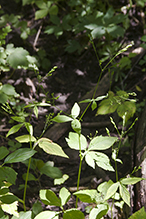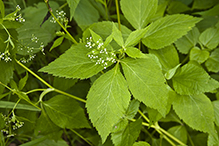Canadian honewort
(Cryptotaenia canadensis)
Conservation • Wetland • Description • Habitat • Ecology • Use • Distribution • Taxonomy
Description |
||
Canadian honewort is a 12″ to 40″ tall, erect, perennial forb that rises on a single stem from a cluster of fibrous roots. It sometimes forms colonies. It does not flower until the second year. The stems are erect, branched above the middle, light green, and hairless. They are slender, less than 5 ⁄16″ thick. The leaves are alternate and are divided into 3 leaflets. The terminal leaflet is symmetrical. The two lateral leaflets are asymmetrical, with the lower half (away from the terminal leaflet) usually distinctly wider than the upper half. This causes the leaflets to appear somewhat swept forward. Lower leaves are on leaf stalks (petioles) that are up to 4″ long. The petiole forms a sheath at the base that wraps around the stem. The sheath is not inflated. When flattened out it is less than ⅜″ wide. The leaflets are lance-shaped, elliptic, or egg-shaped, 1¼″ to 6″ long, and up to 2″ wide. They are sometimes cut into two unevenly-sized lobes. They taper at the base to a winged leaflet stalk (petiolule) and taper at the tip to a sharp point. The upper and lower surfaces are hairless. The margins are toothed with coarse or fine, sharp, forward-pointing teeth. They are sometimes doubly toothed, the major teeth larger and forward-pointing. The lateral veins of the leaflet branch before reaching the margin, and the branches extend to the tips of the major teeth. The leaves become progressively smaller and shorter stalked as they ascend the stem. Upper leaves are stalkless. The inflorescence is a compound umbel at the end of the stem and each branch appearing in June to July. The umbels are round and 2″ to 3 ″ in diameter, and have 2 to 7 stalks (rays). The rays are ascending, hairless, and 3 ⁄16″ to 2″ long. They are unequal in length length. They are sometimes subtended by a single leaf-like appendage (bract). When present, the bract is linear, sharply pointed, and shorter than the ray. Each ray terminates in a secondary umbel (umbellet). Each umbellet has 2 to 10 stalked flowers. The stalks (raylets) are 1⁄16″ to 1 3 ⁄16″long and are unequal in length. They are sometimes subtended by 1 to 3 bractlets. The bractlets, when present, are lance-shaped, up to ⅛″ long, and shorter than the raylets. Each raylet terminates in a single tiny flower. The flowers have 0 to 5 sepals, 5 petals, 5 stamens, and 2 styles. The ovary is hairless. If present, the sepals are reduced in size to to minute teeth. The petals are white, inversely egg-shaped, and rounded or abruptly pointed at the tip. The fruit is a 2-chambered seedcase (schizocarp). It is green at first, turning dark brown with greenish-yellow ribs at maturity. It is smooth, hairless, narrowly oblong-elliptic, and ⅛″ to ¼″ long. It is more than twice as long as wide. It is slightly flattened laterally and tapers to a short, prolonged extension (beak) at the tip. When ripe, the fruit splits into 2 separate seedcases (mericarps), each with a single seed. Each mericarp has 5 ribs. The ribs are not winged. |
||
Height |
||
12″ to 40″ |
||
Flower Color |
||
White |
||
Similar Species |
||
Habitat |
||
Moderate moisture to moist. Deciduous and mixed forest, woodland margins, stream banks, and thickets. Full shade. |
||
Ecology |
||
Flowering |
||
June to July |
||
Pests and Diseases |
||
|
||
Use |
||
The roots can be cooked and eaten. |
||
Distribution |
||||
|
Sources |
|||
| 3/21/2023 | ||||
Nativity |
||||
Native |
||||
Occurrence |
||||
Common |
||||
Taxonomy |
|||
| Kingdom | Plantae (Plants) | ||
| Division | Tracheophyta (Vascular Plants) | ||
| Subdivision | Spermatophytina (Seed Plants) | ||
| Class | Magnoliopsida (Dicots) | ||
Order |
Apiales (Carrots, Ivies, and Allies) | ||
| Suborder | Apiineae | ||
Family |
Apiaceae (carrot) | ||
| Subfamily | Apioideae | ||
| Tribe | Oenantheae | ||
Genus |
Cryptotaenia (honeworts) | ||
Subordinate Taxa |
|||
|
|||
Synonyms |
|||
Deringa canadensis |
|||
Common Names |
|||
Canadian honewort honewort white chervil wild chervil |
|||
Glossary
Beak
A comparatively short and stout, narrow or prolonged tip on a thickened organ, as on some fruits and seeds.
Bract
Modified leaf at the base of a flower stalk, flower cluster, or inflorescence.
Bractlet
A small, often secondary bract within an inflorescence; a bract that is borne on a petiole instead of subtending it; bracteole.
Linear
Long, straight, and narrow, with more or less parallel sides, like a blade of grass.
Mericarp
The split, usually one-seeded portion of a dry, multi-seeded fruit.
Petiole
On plants: The stalk of a leaf blade or a compound leaf that attaches it to the stem. On ants and wasps: The constricted first one or two segments of the rear part of the body.
Petiolule
The stalk of a leaflet blade on a compound leaf.
Ray
In the Asteraceae (aster) family: a strap-shaped flower, or the strap-shaped portion of a flower. In the Apiaceae (carrot) and Euphorbiaceae (spurge) families: a branch of an umbel.
Raylet
A branch of an umbellet.
Schizocarp
A dry fruit formed from a compound ovary that splits into two or more parts (mericarps) at maturity.
Sheath
The lower part of the leaf that surrounds the stem.
Umbel
A flat-topped or convex, umbrella-shaped cluster of flowers or buds arising from more or less a single point.
Umbellet
A secondary umbel in a compound umbel.
Visitor Photos |
|||||
Share your photo of this plant. |
|||||
| This button not working for you? Simply email us at info@MinnesotaSeasons.com. Attach one or more photos and, if you like, a caption. |
|||||
Kate Thomas |
|||||
Deeply lobed leaves |
|||||
 |
 |
||||
MinnesotaSeasons.com Photos |
|||||
Plant |
|||||
 |
 |
||||
 |
|||||
Leaves |
|||||
 |
 |
||||

Slideshows |
||

Visitor Videos |
|||
Share your video of this plant. |
|||
| This button not working for you? Simply email us at info@MinnesotaSeasons.com. Attach a video, a YouTube link, or a cloud storage link. |
|||
Other Videos |
|||

Visitor Sightings |
|||||
Report a sighting of this plant. |
|||||
| This button not working for you? Simply email us at info@MinnesotaSeasons.com. Be sure to include a location. |
|||||
| Kate Thomas 6/17/2015 |
Location: Afton, Washington County Deeply lobed leaves |
 |
|||
MinnesotaSeasons.com Sightings |
|||||
Avon Hills Forest SNA, North Unit Bertram Chain of Lakes Regional Park Carpenter St. Croix Valley Nature Center Carver Highlands WMA, South Unit Charles A. Lindbergh State Park Clifton E. French Regional Park John Peter Hoffman Spring Brook Valley WMA Nerstrand Big Woods State Park Robert Ney Memorial Park Reserve
|
|||||

|
Created: Last Updated: © MinnesotaSeasons.com. All rights reserved. |
